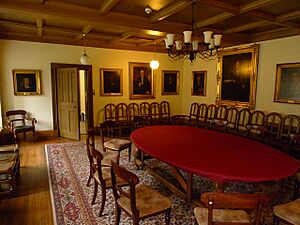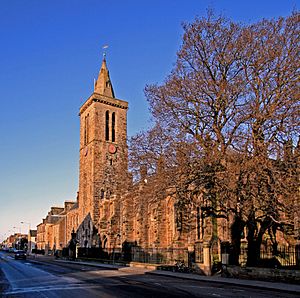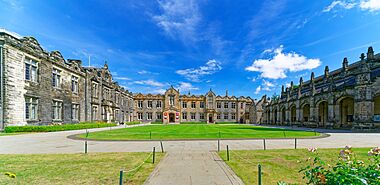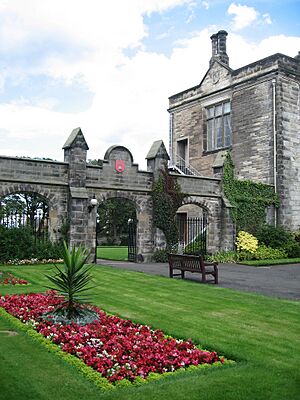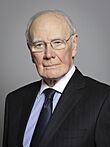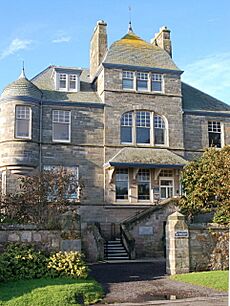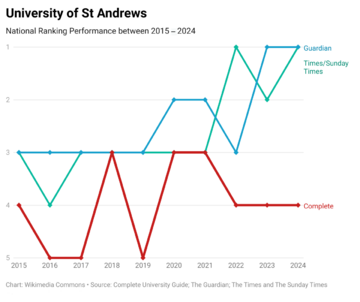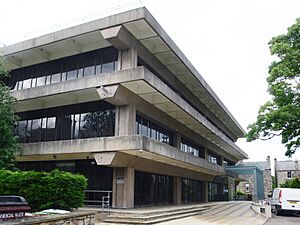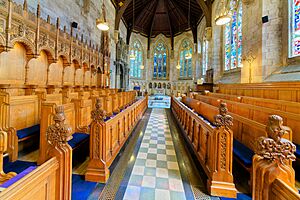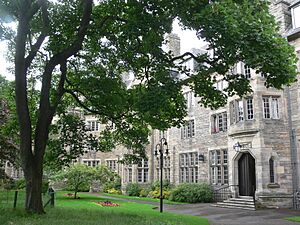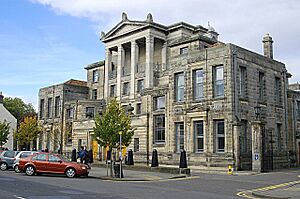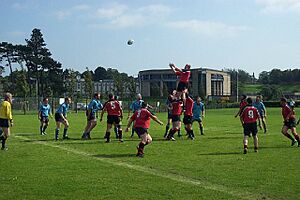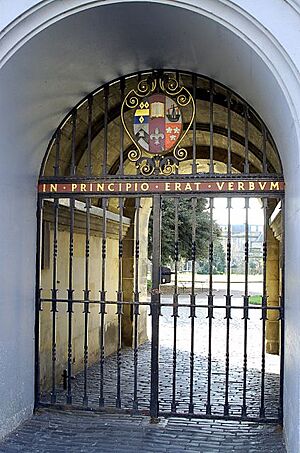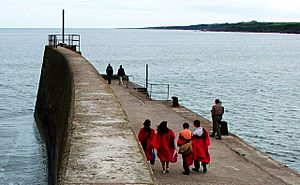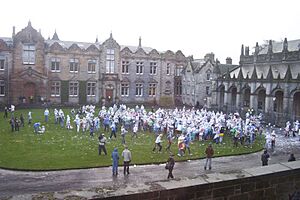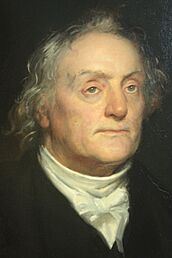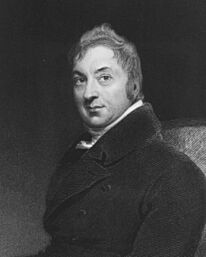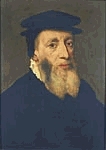University of St Andrews facts for kids

Shield of the University of St Andrews
|
||||||||||||||||||||||||||||||||||||||||||||||||||||||||||||||||||||||||
| Latin: Universitas Sancti Andreae apud Scotos | ||||||||||||||||||||||||||||||||||||||||||||||||||||||||||||||||||||||||
| Motto | ||||||||||||||||||||||||||||||||||||||||||||||||||||||||||||||||||||||||
|---|---|---|---|---|---|---|---|---|---|---|---|---|---|---|---|---|---|---|---|---|---|---|---|---|---|---|---|---|---|---|---|---|---|---|---|---|---|---|---|---|---|---|---|---|---|---|---|---|---|---|---|---|---|---|---|---|---|---|---|---|---|---|---|---|---|---|---|---|---|---|---|---|
|
Motto in English
|
Ever to Excel or Ever to be the Best |
|||||||||||||||||||||||||||||||||||||||||||||||||||||||||||||||||||||||
| Type | Public research university Ancient university | |||||||||||||||||||||||||||||||||||||||||||||||||||||||||||||||||||||||
| Established | 1413 | |||||||||||||||||||||||||||||||||||||||||||||||||||||||||||||||||||||||
| Endowment | £125.9 million (2024) | |||||||||||||||||||||||||||||||||||||||||||||||||||||||||||||||||||||||
| Budget | £310.8 million (2023/24) | |||||||||||||||||||||||||||||||||||||||||||||||||||||||||||||||||||||||
| Chancellor | The Lord Campbell of Pittenweem | |||||||||||||||||||||||||||||||||||||||||||||||||||||||||||||||||||||||
| Rector | Stella Maris | |||||||||||||||||||||||||||||||||||||||||||||||||||||||||||||||||||||||
| Principal and Vice-Chancellor | Dame Sally Mapstone | |||||||||||||||||||||||||||||||||||||||||||||||||||||||||||||||||||||||
|
Academic staff
|
1,345 (2023/24) | |||||||||||||||||||||||||||||||||||||||||||||||||||||||||||||||||||||||
|
Administrative staff
|
1,905 (2023/24) | |||||||||||||||||||||||||||||||||||||||||||||||||||||||||||||||||||||||
| Students | (2015/16) 10,860 FTE (2015/16) |
|||||||||||||||||||||||||||||||||||||||||||||||||||||||||||||||||||||||
| Undergraduates | (2015/16) | |||||||||||||||||||||||||||||||||||||||||||||||||||||||||||||||||||||||
| Postgraduates | (2015/16) | |||||||||||||||||||||||||||||||||||||||||||||||||||||||||||||||||||||||
| Location |
,
,
Scotland, UK
|
|||||||||||||||||||||||||||||||||||||||||||||||||||||||||||||||||||||||
| Campus | University town | |||||||||||||||||||||||||||||||||||||||||||||||||||||||||||||||||||||||
| Colours | United College, St Andrews St Mary's College School of Medicine St Leonard's College |
|||||||||||||||||||||||||||||||||||||||||||||||||||||||||||||||||||||||
| Affiliations |
|
|||||||||||||||||||||||||||||||||||||||||||||||||||||||||||||||||||||||
The University of St Andrews is a public university located in St Andrews, Scotland. It is the oldest of Scotland's four ancient universities. It is also the third-oldest university in the English-speaking world, after the universities of Oxford and Cambridge. St Andrews was started in 1413 when a special permission, called a papal bull, was given by Antipope Benedict XIII to a small group of religious leaders. In the 18th century, St Andrews was an important part of the Scottish Enlightenment, a time of great thinking and learning in Scotland.
St Andrews has three main colleges: United College, St Mary's College, and St Leonard's College. It also has 18 academic schools grouped into four main areas called faculties. The university buildings are spread throughout the historic town of St Andrews. The school year is split into two terms, called Martinmas and Candlemas. During term time, more than one-third of the town's people are either students or staff at the university. Students at St Andrews are known for keeping old traditions alive, like Raisin Weekend, May Dip, and wearing special academic robes.
The student body at St Andrews is very diverse, with students from over 145 different countries. About 47% of students come from outside the UK. A large number, about 20%, are from North America. Getting into St Andrews is quite competitive. In 2022, it had one of the lowest offer rates for new students, meaning it's harder to get in than most other universities.
In 2024, St Andrews was ranked as one of the top universities in the UK for undergraduate education. Many famous people have studied or worked at St Andrews. These include important scientists, thinkers, and politicians. Recent famous alumni include Alex Salmond, a former leader of Scotland, and members of the royal family, William, Prince of Wales, and Catherine, Princess of Wales. Five Nobel Prize winners have also been students or staff at St Andrews.
Contents
History of St Andrews University
How the University Started
In 1410, a group of religious teachers came to St Andrews. They had left other universities because of conflicts happening at the time. They started a place for higher learning, teaching subjects like religion, logic, and law. The Bishop of St Andrews, Henry Wardlaw, officially recognized this group in 1411–12. He then asked Antipope Benedict XIII to give the school university status, which happened in 1413. The King of Scotland, James I of Scotland, also supported the university in 1432.
Over time, more colleges were added. St Salvator's College was founded in 1450. St Leonard's College was started in 1511, focusing more on religious studies. In 1538, St Mary's College was founded for studying religion and law. Even though it was meant to support traditional Catholic teachings, it became a place for training Protestant clergy after Scotland changed its religious views in 1560.
Some of the university buildings from this early period are still used today. These include St Salvator's Chapel, St Leonard's College Chapel, and St Mary's College quadrangle. In those days, most of the teaching was about religion and was done by church leaders.
University Growth and Changes
During the 1600s and 1700s, the university faced many challenges, including civil and religious unrest. In 1747, money problems led to the closing of St Leonard's College. Its buildings and staff joined St Salvator's College to form the United College of St Salvator and St Leonard. During this time, very few students attended. When writer Samuel Johnson visited in 1773, there were fewer than 100 students, and he felt the university was struggling.
Modern University Life
Women at St Andrews
In the late 1800s, there was a growing demand for women to have access to higher education. In 1876, St Andrews decided to allow women to study and earn a diploma, similar to the Master of Arts degree for men. This was called the 'LLA examination'. Women did not have to attend classes in person; they could study from home and take exams.
In 1889, a new law made it possible for women to officially join St Andrews and receive the same education as male students. By 1892, St Leonards School, a ladies' school next to the university, began using the old St Leonard's College buildings to house female students.
The first woman to graduate from St Andrews with the same degree as men was Agnes Forbes Blackadder in 1895. In 1896, Alice Marion Umpherston became the first female lecturer, teaching Physiology to women. To house the growing number of female students, the first women's hall of residence, University Hall, was opened in 1896.
Dundee Connection
Until the early 1900s, St Andrews mainly taught traditional subjects like classical languages and philosophy. It was slow to add newer subjects like science and medicine. To modernize and get more students, the university started a college in Dundee in 1883, which officially joined St Andrews in 1897. The Dundee college focused on science and professional subjects. This partnership allowed St Andrews to offer medical degrees. Many students who earned a degree from St Andrews before 1967 actually studied mostly in Dundee.
In 1967, the connection with Queen's College Dundee (which was the former University College Dundee) ended. It became its own university, the University of Dundee. This meant St Andrews could no longer offer degrees in many areas like Medicine, Law, or Engineering. However, St Andrews later found a way to continue offering medical studies through a new agreement with the University of Manchester in England.
Links with the United States
St Andrews has had ties with the United States for a very long time. James Wilson, who signed the Declaration of Independence, studied at St Andrews. He later became one of the first judges on the Supreme Court of the United States. Other important Americans linked to St Andrews include Andrew Carnegie, a famous industrialist, and Edward Harkness, who helped fund the building of St Salvator's Hall in 1930.
Today, many American students choose to study at St Andrews. In 2017, about 1 in 6 students were from North America. Students from almost every U.S. state and Canadian province attend. This is the highest number of American students at any British university. Many are drawn to St Andrews because of its strong academics, old traditions, and lower tuition fees compared to some U.S. universities.
St Andrews has a large group of former students in the United States, with over 8,000 alumni across all 50 states. Many major cities have alumni clubs. In 2013, Hillary Clinton, a former U.S. Secretary of State, visited St Andrews for its 600th anniversary. She received an honorary degree and spoke about how many American students study there.
University Leadership and Structure
Like other old Scottish universities, St Andrews is run by three main groups: the General Council, the University Court, and the Academic Senate (Senatus Academicus).
General Council
The General Council is a group of all the university's graduates, current and former teachers. They meet twice a year to give advice and choose the university's Chancellor.
University Court
The University Court is in charge of the university's money and daily operations. It is led by the Rector, who is chosen by the students.
Senatus Academicus
The Academic Senate is the top academic group at the university. It includes all professors and some senior teachers. It is responsible for approving degree programs, giving out degrees, and managing student behavior. The head of the Senate is the University Principal.
University Officials
The three most important leaders at the university are the Chancellor, the Principal, and the Rector.
- The Chancellor is the ceremonial head of the university. They give out degrees and help promote the university around the world.
- The Principal is the chief executive, meaning they are in charge of the university's daily operations. They lead the University Senate.
- The Rector is chosen by the students. They lead meetings of the University Court and make sure students' needs are heard. Many famous people have been Rector, including actor John Cleese and writer Rudyard Kipling.
University Colleges
The university has three colleges: United College, St Mary's College, and St Leonard's College. These colleges are mostly for tradition, as students live in separate dorms or private homes. United College is for students studying arts, sciences, and medicine. St Mary's College is for students studying religion. St Leonard's College is for all postgraduate students. In 2022, the university announced plans for a fourth college, New College, for International Relations and the new Business School.
Academic Faculties and Schools
The university has four main academic areas called faculties, which include 18 different schools. A dean is chosen to manage each faculty. Students apply to a faculty, not directly to a school. The faculties and their schools are:
- Faculty of Arts: Includes art history, classics, economics, English, film studies, history, international relations, management, modern languages, philosophy, and social anthropology.
- Faculty of Divinity: Focuses on divinity (religious studies).
- Faculty of Medicine: Focuses on medicine.
- Faculty of Science: Includes biology, chemistry, computer science, geography and geosciences, mathematics, physics and astronomy, psychology, and neuroscience.
Some subjects, like economics, geography, and mathematics, are offered in both the Arts and Science faculties. The content of these subjects is the same no matter which faculty they are in.
University Academics
Academic Terms
The academic year at St Andrews is split into two terms: Martinmas and Candlemas. Martinmas term runs from early September to mid-December, with exams before the Christmas break. Candlemas term starts in January and ends with exams in April and May. Most undergraduate students graduate in mid-June, and postgraduate students graduate in late November.
University Rankings and Reputation
In recent years, St Andrews has been ranked as one of the top universities in the UK. In 2022, it was named the best university in the UK by The Times and Sunday Times Good University Guide, a first for any university to rank above Cambridge and Oxford. It also ranked first in The Guardian University Guide in 2023 and 2024. St Andrews has been named "University of the Year" twice by The Times and Sunday Times.
St Andrews is also known for its teaching quality, ranking 5th in Europe in 2019 by Times Higher Education. It consistently ranks among the top universities in the UK for research quality. St Andrews is also highly rated for helping its graduates find jobs. In 2017, it had one of the highest graduate employment rates in the UK, with 97.7% of its graduates working or continuing their studies three and a half years after graduating.
Many subjects at St Andrews are highly ranked. In the 2026 Complete University Guide, 25 out of 26 subjects offered by St Andrews were in the top 5 nationally. This includes English, German, Business and Management, Chemistry, and International Relations, which were all ranked very highly.
Student Admissions
Getting into St Andrews is very competitive. The university receives many applications for a limited number of places. In 2022, only about 24.7% of undergraduate applicants received an offer, making it one of the hardest universities to get into in the UK, after Oxford and Cambridge. Students who get in usually have very high grades.
In 2015/16, St Andrews had students. The university has a diverse student body, with many students from different ethnic backgrounds. More female students attend than male students. St Andrews works to encourage students from all backgrounds to apply, including those from lower-income areas.
Exchange Programs
St Andrews has student exchange programs with universities around the world, especially in North America, Europe, and Asia. These programs allow students to study abroad for a period.
One special program is the Bachelor of Arts International Honours program with the College of William & Mary in the U.S. Students can spend two years at each university and earn a joint degree. St Andrews also has exchanges with many universities in the University of California system, like UC Berkeley and UCLA.
In Europe, St Andrews participates in the Erasmus Programme and has direct exchanges with universities in France, the Netherlands, and other countries. There are also exchanges with universities in Asia and Oceania, such as the University of Hong Kong and the University of Melbourne.
University Buildings and Facilities
The University of St Andrews is located in the small town of St Andrews in Scotland. Its teaching buildings, libraries, student housing, and other facilities are spread throughout the town. Key university areas are on North Street, South Street, The Scores, and the North Haugh.
The United College, St Andrews (also known as the Quad) on North Street is used for teaching and student events. St Mary's College, St Andrews, on South Street, houses the Schools of Divinity, Psychology, and Neuroscience. Many other schools, like Classics, English, and History, are located on The Scores. The North Haugh area is home to science departments like Chemistry, Physics, and Biology.
Libraries and Museums
The University of St Andrews has one of the largest university library collections in the UK. It holds over a million books and more than two hundred thousand rare and old books.
The university library was started by King James VI in 1612. From 1710 to 1837, it was a legal deposit library, meaning it received a copy of every book published in the UK. The main library building on North Street was updated in 2011. The historic King James Library, built in 1643, holds the university's collections on religion and medieval history.
The university also has several museums and galleries that are free to visit. The Museum of the University of St Andrews (MUSA) opened in 2008 and shows off some of the university's 100,000 artifacts. These include items about the university's history and paintings by famous artists.
The Bell Pettigrew Museum displays the university's natural history collections. It has remains of extinct animals like the dodo and Tasmanian tiger.
University Chapels
The university has two chapels. The chapel of St Salvator's was founded in 1450 and is a central part of university life. It has six bells, making it the only university chapel in Scotland suitable for change ringing (a special way of ringing bells). The Chapel of St Leonard's is the university's oldest building, with parts dating back to 1144. Both chapels have student choirs.
Student Halls of Residence
Many students at St Andrews live in university-owned housing. In 2012, 52% of students lived in university halls. The halls are different ages and styles, from the 12th-century Deans Court to the modern Whitehorn Hall built in 2018. All halls are now for both male and female students and are smoke-free. Some halls provide meals. The university guarantees a place for all first-year students, and many students choose to stay in halls in later years.
Halls of residence include:
- Agnes Blackadder Hall
- Andrew Melville Hall
- David Russell Apartments
- Fife Park Apartments
- Gannochy House
- John Burnet Hall
- McIntosh Hall
- Powell Hall (for postgraduate students)
- St Regulus Hall
- St Salvator's Hall
- University Hall
- Whitehorn Hall (part of University Hall)
- Angus and Stanley Smith Houses (for postgraduate students)
- Deans Court (for postgraduate students)
- St Gregory's (for postgraduate students)
- Gregory Place (for postgraduate students)
Renewable Energy Projects
St Andrews is working to be a very environmentally friendly university. Since 2013, the university's investments have followed sustainable and ethical policies. The university also runs the international St Andrews Prize for the Environment, which gives money to environmental projects worldwide. The university aims to be the UK's first carbon net zero university by 2035. It has invested in a biomass center and plans for solar and wind farms.
The Guardbridge Biomass Energy Centre uses wood fuel from the local area to create heat and power for the university. This project is expected to save 10,000 tonnes of carbon each year. The biomass center started working in December 2016 and won a Scottish Green Energy Award in 2023.
Student Life at St Andrews
Students' Association
The University of St Andrews Students' Association is the group that represents all the students. It was founded in 1885. The Students' Association building, often called the Union, is where students can find bars and student support services. The building was renovated in 2013.
Student Societies
St Andrews has over 200 student societies, covering many different interests.
The oldest student society is the University of St Andrews Celtic Society, which started in 1796. It promotes Scottish culture through Scottish Country Dance and Scottish Gaelic language classes.
All students are part of the "Union Debating Society". This group holds weekly debates, invites famous speakers, and competes in national and international debating contests. It claims to be the oldest continuously running student debating society in the world, tracing its roots back to 1794.
St Andrews also has a strong tradition of student media. The university has two newspapers, The Saint and The Stand. There are also student magazines like The Wynd and ST.ART, and academic journals. The university's radio station is STAR: St Andrews Radio, which broadcasts online during term time.
The university's Music Society includes many student-run music groups, such as the symphony orchestra and chorus. There are also four A Cappella groups: The Other Guys, The Alleycats, The Accidentals, and The Hummingbirds.
Student theatre is supported by the Mermaids Performing Arts fund. Students put on plays and comedy shows at the Byre Theatre. Blind Mirth is the university's improvisational theatre group, which performs weekly and at the Edinburgh Fringe Festival.
The Kate Kennedy Club is important for keeping university traditions alive, like the Kate Kennedy Procession, where students dress up as famous people from the university's past. The club also organizes social events. In 2012, the club started allowing female students to join.
Sports Clubs and the Athletic Union
The University of St Andrews Athletic Union represents student sports. It was started in 1901 and includes about sixty sports clubs. These clubs compete at both fun and high-performance levels. A well-known club is the University of St Andrews Rugby Football Club, which helped shape the sport of rugby.
In 2015, the university spent £14 million to improve its sports center. This included a new sports hall and expanded gym facilities.
The The Scottish Varsity, also called the 'world's oldest varsity match', is an annual rugby game played against the University of Edinburgh.
University Traditions
Sponsio Academica
To become a student at St Andrews, you must agree to an oath in Latin called the Sponsio Academica. Today, this is done online when you register. The oath is a promise to respect teachers, follow university rules, and help the university succeed. It also states that students who behave badly or don't study enough can be punished or even expelled.
University Blessings and Graces
The tradition of saying blessings before and after meals was brought back in 1887. These blessings are said in Latin.
University Blessing: Sit nomen Domini Benedictum per Jesum Christum salvatorem nostrum. Amen. (Blessed be the name of the Lord through Jesus Christ, our Saviour. Amen.)
University Grace: Before Meat: Gloria Patri Filio Spirituique Sancto In Saecula Saeculorum. Amen. (Glory be to the Father, the Son, and the Holy Spirit. World Without End. Amen.)
After Meat: Deo Gratias. (Thanks be to God.)
Academic Gowns
One of the most noticeable traditions at St Andrews is wearing academic robes. Undergraduate students in Arts and Science subjects wear a special red gown. You can see students wearing these gowns at special events, chapel services, formal dinners, and when giving tours. Divinity students wear a black gown with a purple cross. Postgraduate students wear a different black gown. The way students wear their gowns changes each year to show what year they are in. For example, first-year students wear the gown on their shoulders, while fourth-year students wear it off their elbows.
Student Years and Nicknames
First-year male students are called "Bejants," and first-year female students are called "Bejantines." These names come from a French term meaning "yellow beak" or "nestling." Second-year students are called "Semis," third-year students are "Tertians," and final-year students are "Magistrands." These terms are thought to be unique to St Andrews.
Academic Parents
Students at St Andrews have a unique "family tradition." New first-year students get "academic parents," who are older students (at least in their third year). These academic parents informally guide and mentor the new students in their studies and social life. This tradition helps new students feel welcome.
Raisin Weekend Celebration
Raisin Weekend celebrates the bond between first-year students (Bejants/Bejantines) and their academic parents. Historically, first-year students would give their academic parents a pound of raisins as a thank you for their guidance. Today, students usually give a bottle of wine or another small gift instead. In return, the parents give their "children" a funny receipt written in Latin. First-year students must carry this receipt with them on Raisin Monday morning.
Raisin Weekend happens every year on the last weekend of October. It often starts with a tea party, followed by social gatherings led by the academic fathers. On Raisin Monday, all first-year students gather in the Quad of St Salvator's College to compare their Latin receipts. Older students might check for mistakes in the Latin, and if found, the first-year student might have to sing a song. The event usually ends with a large shaving foam fight.
The Curse of Patrick Hamilton
Around St Andrews, there are cobblestone markings that show where Protestant martyrs were burned at the stake. The most famous one is the initials "PH" outside the main gate of St Salvator's College. This marks where Patrick Hamilton was martyred in 1528. According to student tradition, stepping on the "PH" will cause a student to fail their degree. So, students often jump over these cobblestones. The 'curse' is said to be lifted by taking part in the May Dip.
May Dip Tradition
The May Dip is a student tradition held every year at dawn on May Day. Students typically stay awake all night, then run into the North Sea together as the University Madrigal Group sings. Students do this to "cleanse" themselves of any academic "sins" (like stepping on the PH cobblestone) before their exams in May.
Notable People from St Andrews
Famous Alumni
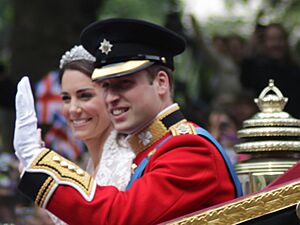
Many notable people have studied at the University of St Andrews. These include:
- King James II of Scotland
- James Wilson (1761), who signed the United States Declaration of Independence
- John Napier (1563), who discovered logarithms
- John Knox (1531), who founded the Church of Scotland
- Thomas Chalmers, a leader of the Church of Scotland
- Edward Jenner (1792), who pioneered the smallpox vaccine
- William, Prince of Wales (2005) and Catherine, Princess of Wales (2005)
Alumni have also become leaders in business, finance, and politics. These include CEOs of major companies like BHP (Andrew Mackenzie) and BP (Robert Horton). In politics, former students include Alex Salmond, a former leader of Scotland, and Mark Sedwill, a former top government official.
From media and the arts, notable alumni include B. C. Forbes, who founded Forbes magazine, and Louise Minchin, a BBC News presenter.
The university also has many honorary graduates, including famous figures like Benjamin Franklin, Hillary Clinton, Bob Dylan, and David Attenborough.
Famous Academics
- Maurice Wilkins (lecturer in physics 1945–1946), a Nobel Prize in Medicine winner
- Percy Theodore Herring (professor of medicine 1908–1948), who discovered herring bodies
- Richard Morris, who developed the Morris water navigation task at the university's Gatty Marine Laboratory
- D'Arcy Wentworth Thompson, a famous biologist
- Norman Haworth, a chemist
- Kenneth Dover, a classicist
- Andrew Melville, a theologian
- James Gregory, a mathematician
- David Brewster, a physicist
- Adam Ferguson, a philosopher
See also
 In Spanish: Universidad de Saint Andrews para niños
In Spanish: Universidad de Saint Andrews para niños
- Category:Academics of the University of St Andrews
- Chancellor of the University of St Andrews
- St Andrews Cathedral
- List of medieval universities
- Gaudy
- Town and gown


